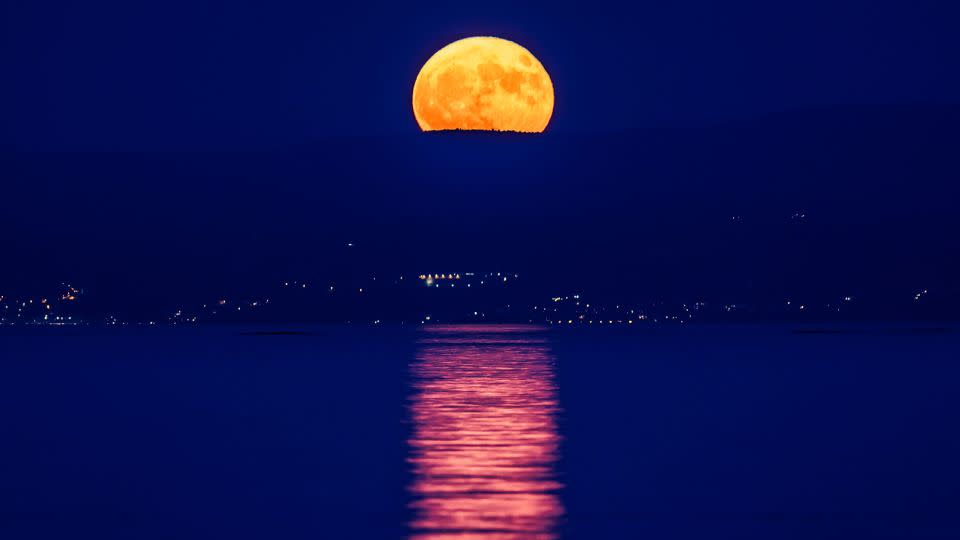July’s full moon coincides with the anniversary of a special lunar event

Sign up for CNN’s Wonder Theory science newsletter. Explore the universe with news on fascinating discoveries, scientific advancements and more.
July’s full moon will shine bright in the sky this weekend — and lands near the anniversary of a special lunar event worth celebrating.
The full moon — nicknamed the buck moon — will peak at 6:17 a.m. ET Sunday, according to The Old Farmer’s Almanac. It’s called the buck moon because male deer, or bucks, fully grow their antlers at this time of year, the almanac says.
But since the moon appears full for a few days a month surrounding its peak, the best time to view it might be on Saturday to mark the 55th anniversary of the Apollo 11 lunar landing, the first space mission to bring humans to the moon, said Noah Petro, chief of NASA’s Planetary Geology, Geophysics and Geochemistry Laboratory.
“The first moon landing was in the afternoon on (July 20, 1969), and then they did the moonwalk that night,” Petro said. “There’s no better way to celebrate that than by going outside and looking at the full moon and toasting Neil (Armstrong), Buzz (Aldrin) and Michael Collins, and all the people who helped make Apollo 11 a reality 55 years ago.”
How to view the full moon
Local weather conditions allowing, the full moon will be visible to those in the Northern and Southern hemispheres, Petro said. For optimal moon gazing, he recommends finding a spot with a clear view of the sky, away from tall buildings and trees. Even in cities with a lot of light pollution, the moon will be visible in a clear night sky.
No equipment is needed to view a full moon, but a telescope or pair of binoculars could enhance its features — the dark areas that can be observed on the moon are “vast volcanic lava flows that are billions of years old,” Petro said.
“Even with the naked eye … you can start seeing the history of the moon in front of you. And that’s one of the reasons why I love studying the moon — is that it’s laid bare for folks to see,” he added. “On a beautiful full moon clear night, you can see differences in color, you can see differences on the surface that all go back to the history of the moon.”
To the average observer, the buck moon will look like almost every other full moon, Petro said. But each full moon varies month to month, due to its slightly shifting orientation, known as libration, and the changing distance from Earth in its elliptical orbit. To observe the different perspectives, Petro recommends taking a photo of each lunar event as it occurs and then compare it with the next one.
And for those looking to catch a glimpse of other celestial bodies, Saturn, Mars, Jupiter and Uranus can also be observed in early morning hours during July, according to NASA’s monthly sky-watching highlights video.
Lunar discoveries
NASA’s Artemis program aims to return astronauts to the moon for the first time since Apollo 17 in 1972. The space agency plans to establish the first lunar outpost and further explore the moon, contributing to new discoveries about our nearest celestial neighbor.
Recently, scientists confirmed the first direct evidence of a cave on the moon using radar data from NASA’s Lunar Reconnaissance Orbiter, which has been collecting data since its launch in June 2009. Researchers discovered the cave connected to a pit found within a vast plain called Mare Tranquillitatis, or the Sea of Tranquility, the same region where Apollo 11 astronauts landed in 1969.
“When we went to the moon 55 years ago, we knew very little about it — we didn’t know how old it was, how it formed, the processes that have changed it over its life,” said Petro, who is also the project scientist for both the Lunar Reconnaissance Orbiter and Artemis III.
“Every time we learned something new about the moon, whether it’s about caves on the lunar surface or samples that are returned … we also realize how little we (still) know about the moon.”
Discoveries about the moon help us better understand other planets, Petro added. NASA hopes further lunar revelations will lead to the first human setting foot on Mars.
Petro recommends observing the full moon with these recent findings and future space missions in mind. And if you miss this full moon, there is always the next one, he added.
Remaining moons of 2024
There are five more full moons set to shine this year, according to the Farmers’ Almanac. Here are their peak dates:
August 19: Sturgeon moon
September 17: Harvest moon
October 17: Hunter’s moon
November 15: Beaver moon
December 15: Cold moon
For more CNN news and newsletters create an account at CNN.com

